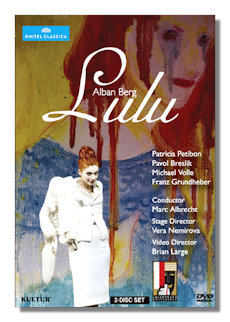
The Internet's Premier Classical Music Source
Related Links
- Berg Reviews
- Latest Reviews
- More Reviews
-
By Composer
-
Collections
DVD & Blu-ray
Books
Concert Reviews
Articles/Interviews
Software
Audio
Search Amazon
Recommended Links
Site News
 DVD Review
DVD Review
Alban Berg

Lulu
Three-Act version completed by Friederich Cerha
- Lulu - Patricia Petibon
- Countess Geschwitz - Tanja Ariane Baumgartner
- The Painter - Pavol Breslik
- Dr. Schön/Jack the Ripper - Michael Volle
- Alwa - Thomas Piffka
- A Theatrical Dresser/A High School Boy - Cora Burggraaf
- Schigolch - Franz Grundheber
- An Animal Tamer/An Athlete - Thomas Johannes Mayer
- The Prince/The Manservant - Heinz Zednik
- The Marquis - Andreas Conrad
Vienna Philharmonic Orchestra/Marc Albrecht
Stage Director - Vera Nemirova
Video Director - Brian Large
Set Designs - Daniel Richter
Live at the Felsenreitschule - 2010 Salzburg Festival
Unitel Classica/Kultur DVD D4779 182min Widescreen LPCM Dolby Digital
Also available on Blu-ray BD4779: Amazon - UK - Germany - Canada - France - Japan - ArkivMusic - CD Universe - JPC
While movies and other entertainment media advance technologically with ever-inventive special effects, opera has understandably been less aggressive in its attempts to keep up. Sets and other production aspects typically depend on the audience's imagination to have proper effect. This effort, however, while presenting no visual sleight-of-hand effects, does advance the visual scope of opera with clever background scenery and sets, effective costuming and makeup, and characters who come across with a bold manner of expression.
In the opening scene, for example, the backdrop is a large and strikingly surreal painting of Lulu, who appears on stage just as surreal in her attire of white undergarments and white angel wings. The Painter in the same scene wears white work clothes as well, but smeared with multi-colored paint, which might represent his ability to have feelings and compassion, as opposed to the opportunistic Lulu's lack of either. There are many other imaginative touches in this production, including the pyramid structure later on from which characters emerge through windows like puppets. The sets and paintings, by the way, are by Daniel Richter, one of the more highly respected German painters on the scene today.
To those unfamiliar with Lulu, let me give a very brief summary of her character and the story. Lulu, formerly a low-class girl, is married to the elderly Dr. Goll, but is mistress to Dr. Schön, who had rescued her years before from the gutter. In the First Act Goll catches Lulu with the Painter, and dies of a stroke, leaving Lulu a wealthy widow. She marries the Painter, who is eventually driven to suicide. Lulu then marries Schön, whom she eventually murders. She escapes prison and ends up a prostitute in London, where she is murdered by Jack the Ripper. In the end, Lulu, the amoral vamp, turns out to be a danger to everyone enamored of her, wreaking death to her lovers, even to an admiring lesbian, Countess Geschwitz, who is also murdered by the Ripper in the final scene.
As mentioned in the heading, this version of the opera is the now standard complete rendition, the Third Act orchestrated by composer Friedrich Cerha. This production, imaginatively directed by Vera Nemirova, was well received at the 2010 Salzburg Festival, but let me caution those unfamiliar with Lulu that its atonal musical language could prove a somewhat difficult mountain to climb. That said, it is hardly avant-garde by today's standards and in the end must be regarded as a masterpiece of 20th century opera. Berg was far more Romantic than Schoenberg and this work divulges an expressive language not too far in advance of late Mahler.
In this production Lulu is scantily clad much of the time and her childish manner is almost cartoonish in her over-the-top makeup, red hair, carefree looks and utterly unscrupulous manner. While you admire Patricia Petibon for her brilliant portrayal of Lulu, you will not shed half a tear over her character's violent demise! Petibon is probably best known in Baroque repertory, particularly in works by Handel, Charpentier, Couperin, Lully, Rameau, Gluck and others. But she has sung 20th century opera, including Poulenc's Dialogues of the Carmelites (Constance). She makes an excellent Lulu, both vocally and dramatically. The rest of the cast is generally good too, in particular Pavol Breslik as the Painter and Michael Volle as Schön.
The Vienna Philharmonic, under the deft direction of Marc Albrecht, plays brilliantly throughout. It would be hard to imagine this tough score rendered with more commitment and spirit. The camera work is excellent too and the sound vivid. The only thing that didn't work well, to me, was the opening of the Third Act, which was sung/spoken from the aisles of the Felsenreitschule amid the audience. This whole episode had a chaotic air about it. Still, that's only a minor blemish on this otherwise excellent effort.
Copyright © 2012, Robert Cummings




















